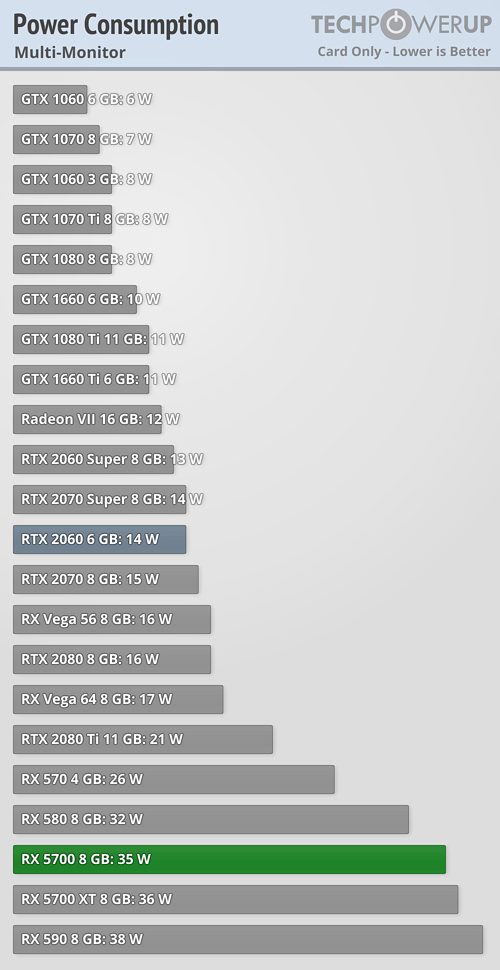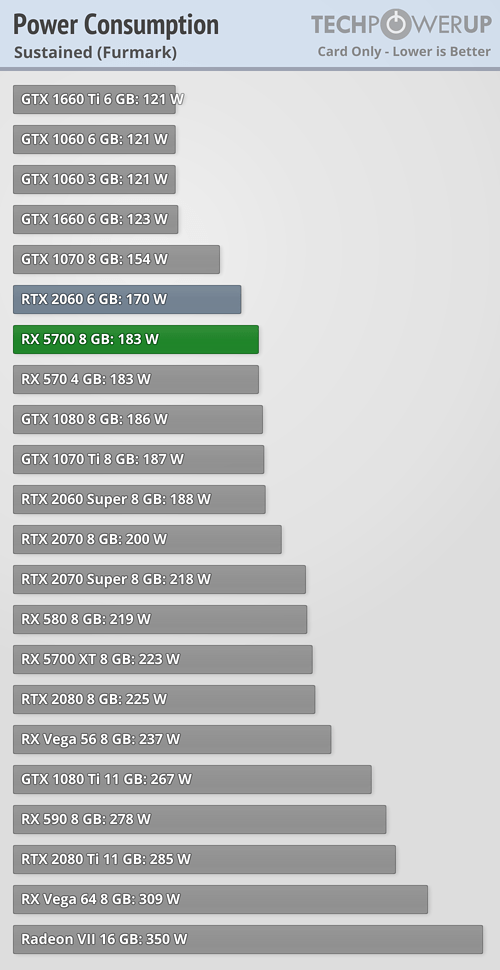 46
46
AMD Radeon RX 5700 Review
Temperatures & Fan Noise »Power Consumption
Single monitor idle power consumption has been greatly improved over previous Vega cards. With only 8 watts in idle, it's now right where it should be.
Unfortunately, multi-monitor power consumption is still bad, nearly three times that of competing NVIDIA cards.
Media playback power draw is good—lower than on any other AMD card and better than NVIDIA's RTX lineup.
Gaming power draw is surprisingly low with just 166 W and matches the 164 W of the RTX 2060 almost exactly, yet the RX 5700 is faster at the same time. Now, you should be screaming "Whaaaat?! Does that mean the RX 5700 is more power efficient than RTX 2060?" Yes, that's true. AMD has achieved the unimaginable and managed to make their card 3%–5% more power efficient than the RTX 2060. How did they achieve this? The trick is basically to undervolt the card a lot. More on that on our Clock Speeds & Power Limit page (page 32).






Apr 3rd, 2025 16:26 EDT
change timezone
Latest GPU Drivers
New Forum Posts
- Windows 11 General Discussion (5920)
- Someone knowledable on memory voltages want to chime in? (also what is PMIC and should I be worried) (3)
- Help me decide if I should buy the arc B580 (As a backup) (11)
- Help me pick a UPS (47)
- New AM5 build [help] (15)
- 4x16gb how are these? (12)
- New posts added to last post (2)
- What's your latest tech purchase? (23459)
- Free Games Thread (4610)
- Gigabyte graphic card - TIM GEL application failure? (15)
Popular Reviews
- DDR5 CUDIMM Explained & Benched - The New Memory Standard
- Sapphire Radeon RX 9070 XT Pulse Review
- SilverStone Lucid 04 Review
- PowerColor Radeon RX 9070 Hellhound Review
- Sapphire Radeon RX 9070 XT Nitro+ Review - Beating NVIDIA
- Pwnage Trinity CF Review
- Palit GeForce RTX 5070 GamingPro OC Review
- ASRock Phantom Gaming B850 Riptide Wi-Fi Review - Amazing Price/Performance
- AMD Ryzen 7 9800X3D Review - The Best Gaming Processor
- Samsung 9100 Pro 2 TB Review - The Best Gen 5 SSD
Controversial News Posts
- MSI Doesn't Plan Radeon RX 9000 Series GPUs, Skips AMD RDNA 4 Generation Entirely (146)
- Microsoft Introduces Copilot for Gaming (124)
- AMD Radeon RX 9070 XT Reportedly Outperforms RTX 5080 Through Undervolting (119)
- NVIDIA Reportedly Prepares GeForce RTX 5060 and RTX 5060 Ti Unveil Tomorrow (115)
- Over 200,000 Sold Radeon RX 9070 and RX 9070 XT GPUs? AMD Says No Number was Given (100)
- NVIDIA GeForce RTX 5050, RTX 5060, and RTX 5060 Ti Specifications Leak (96)
- Retailers Anticipate Increased Radeon RX 9070 Series Prices, After Initial Shipments of "MSRP" Models (90)
- China Develops Domestic EUV Tool, ASML Monopoly in Trouble (88)